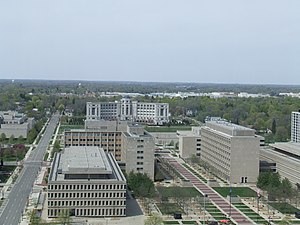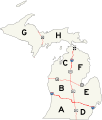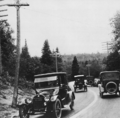Portal:Michigan highways
Michigan Highways
The State Trunkline Highway System of the US state of Michigan is a network of roads owned and maintained by the Michigan Department of Transportation (MDOT). The most prominent of these roads are part of one of three numbered highway systems in Michigan: Interstates Highways, US Highways, and the other State Trunklines. Other systems of roads are operated by the 83 counties in the state as well as each city.


Interstate Highways and US Highways are assigned at the national level. Interstate Highways are numbered in a grid—even-numbered highways are east–west highways (with the lowest numbers along Mexico and the Gulf of Mexico), and odd-numbered highways are north–south highways (with the lowest numbers along the Pacific Ocean). US Highways are also numbered in a grid—even numbered for east–west highways (with the lowest numbers along Canada) and odd numbered for north–south highways (with the lowest numbers along the Atlantic Ocean). For this reason, mainline (two-digit) Interstate Highways in Michigan all have numbers above 69 and mainline US Highways all have numbers below 45. Three-digit Interstate and U.S. Highways, also known as "child routes," are branches off their main one- or two-digit "parents". The Interstate and US Highways are maintained by MDOT. Interstate 75 (I-75) and US Highway 23 (US 23) are the longest examples in the state.


State Trunklines are the other state highways maintained by MDOT. These highways are completely owned and maintained by the state. Michigan highways are properly referred to using the M and never as "Route 28" or "Highway 115", but as M-28 or M-115. The marker used for state trunklines is a diamond with a block-letter "M" at the top. Roads that are maintained by the state but not assigned a state trunkline designation carry an unsigned highway designation.


County-Designated Highways are assigned numbers in a zone system by MDOT, but maintained by the counties. Each zone is indicated by a letter A–H which is followed by a number based on a grid inside that zone. Each county also maintains any other roadway that is not a state trunkline or a city street. The numbering and signing practices vary from county to county, as does the size of each county's system. Numerical designations typically do not carry over from one county to the next; a CDH that crosses county lines keeps its designation in each county however. County road designations are typically abbreviated "CR" or "Co Rd" followed by the number, and CDHs are abbreviated to just their letter and number assignment.
US Highway 131 (US 131) is a north–south United States Highway, of which all but 0.64 of its 269.96 miles (1.03 of 434.46 km) are within the state of Michigan. The highway starts in rural Indiana south of the state line as a state road connection to the Indiana Toll Road. As the road crosses into Michigan it becomes a state trunkline highway that connects to the metropolitan areas of Kalamazoo and Grand Rapids before continuing north to its terminus at Petoskey. US 131 runs as a freeway from south of Portage through to Manton in the north. Part of this freeway runs concurrently with Interstate 296 (I-296) as an unsigned designation through Grand Rapids. US 131 forms an important corridor along the western side of the Lower Peninsula of Michigan, running through rural farm and forest lands as well as urban cityscapes. Various names have been applied to the roadway over the years. The oldest, the Mackinaw Trail, originated from an Indian trail in the area while other names honored politicians. An attempt to dedicate the highway to poet James Whitcomb Riley failed to gain official support in Michigan.
The first state highways along the US 131 corridor were designated as early as 1919. When the US Highway System was formed on November 11, 1926, US 131 was created along the route of M-13 in Michigan. Originally ending at Fife Lake on the north end, the highway was extended to Petoskey in the late 1930s. Further changes were made, starting in the 1950s, to convert segments of the road to a full freeway. The state started this conversion simultaneously at two locations: heading north from Three Rivers, and heading both north and south from a point in southern Kent County. A third segment was built south of Cadillac and over subsequent years Michigan filled the gaps in the freeway. Cadillac and Manton were bypassed in the early part of the 21st century, resulting in the current freeway configuration. Another large-scale construction project in 2000 rebuilt an unusual section of the freeway through Grand Rapids known as the S-Curve. Two bridges formerly used by US 131 have been labeled by the Michigan Department of Transportation (MDOT) as historic structures; one of them has been listed on the National Register of Historic Places (NRHP). (Full article...)General images
Selected picture

Topics
State Trunkline System, overview of the system
- Interstates Highways in the state
- US Highways in the state
- State Trunklines
- County-Designated Highways in the state
- Pure Michigan Byways, a system of scenic, historical or recreational highways in the state
- Great Lakes Circle Tour
Subcategories
Related portals
WikiProjects
Things to do
Nominations and votes for selected articles and selected pictures are always needed. Anyone can nominate an article, and anyone can vote for an article. You can also recommend items for Did you know?. Improvements to the articles are always welcome as the project works on expanding and nominating the remaining ones for Good Article or Featured Article status.





























